Home >
Air >
Pollution Sources >
Energy Production >
Fossil Fuels >
Fuel Regulations >
Sulphur in Gasoline Regulations >
Sulphur in Liquid Fuels - 2007
Sulphur in Liquid Fuels - 2007
November 2009
Acknowledgements
- Prepared By:
-
Raseeka Rahumathulla
Oil, Gas and Alternative Energy Division
Energy and Transportation Directorate
Environment Canada
- In collaboration with:
-
Jeffrey Guthrie
Environment Canada
- and
-
Shivam Shah
Co-op Student – University of Waterloo
- and
-
Sneha Mathrani
Co-op Student – University of Waterloo
Notice
The information contained in this report is compiled from data submitted, as of July 2009, by the producers and importers of liquid fuels in Canada pursuant to the requirements of the federal Fuels Information Regulations, No. 1.
Submissions have been verified for plausibility but are subject to potential errors made at the source.
Any comments on the content of this report should be directed to:
Fuels Section
Oil, Gas, and Alternative Energy Division
Environment Canada
Place Vincent Massey, 9th Floor
Gatineau, Quebec
K1A 0H3
Fax: 819-953-8903
Email: fuels-carburants@ec.gc.ca.
Table of Contents
Appendices
- Appendix 1
- Appendix 2
- Appendix 3
- Appendix 4
- Appendix 5
- Appendix 6
List of Graphs
- 1.1 Sulphur Levels in Gasoline by Region and Nationally, 1995–2007
- 1.2 National and Regional Trends of Sulphur Content in Gasoline, 1999–2007
- 1.3 Sulphur Mass in Liquid Fuels by Region and Nationally, 1996–2007
- 4.1 National Liquid Fuel Production/Imports in 2007
- 4.2 Tonnage of Sulphur in Liquid Fuels in 2007
- 4.3 Mass of Sulphur in Liquid Fuels Produced/Imported in 2007
- 4.4 Sulphur Mass in Liquid Fuels by Region and Nationally, 1996–2007
- 4.5 Average Sulphur Levels in Motor/Aviation Gasoline by Region and Nationally, 1995–2007
- 4.6 Average Sulphur Levels in Motor Gasoline by Refiner/Importer in 2007
- 4.7 Average Sulphur Levels in Ultra-Low-Sulphur Diesel Fuel by Refiner/Importer in 2007
- 4.8 Average Sulphur Levels in Low-Sulphur Diesel Fuel by Refiner/Importer in 2007
- 4.9 Average Sulphur Levels in High-Sulphur Diesel Fuel by Refiner/Importer in 2007
- 4.10 National Trend of Sulphur Content in Aviation Turbo Fuel, 1995–2007
- 4.11 National Trend of Sulphur Content in Motor/Aviation Gasoline, 1995–2007
- 4.12 National Trend of Sulphur Content in Kerosene/Stove Oil, 1995–2007
- 4.13 National Trend of Sulphur Content in Diesel Fuel (Total Pool), 1995–2007
- 4.14 National Trend of Sulphur Content in Light Fuel Oil, 1995–2007
- 4.15 National Trend of Sulphur Content in Heavy Fuel Oil, 1995–2007
List of Tables
Top of Page
1.0 Executive Summary
This report summarizes the 2007 data on the sulphur content in liquid fuels originating from crude oils, coal or bituminous sand. The information was provided to Environment Canada by producers and importers of liquid fuels pursuant to the federal Fuels Information Regulations, No. 1 of the Canadian Environmental Protection Act, 1999.
During 2007, there were various developments with respect to federal regulations on sulphur in liquid fuels and other non-regulatory issues:
- The new 500 mg/kg limit for off-road diesel fuel and rail and marine diesel fuel came into effect under the Sulphur in Diesel Fuel Regulations. The limits and timing were:
- 500 mg/kg for production or imports as of June 1, 2007; and
- 500 mg/kg for sales as of October 1, 2007.
In late 2006, the new 15 mg/kg limit for on-road diesel fuel was implemented, the effect of which is seen in the 2007 sulphur levels.
- The limits and timing of the various developments with respect to the Sulphur in Diesel Fuel Regulations, in 2006, were:
- 15 mg/kg for production and import as of June 1, 2006;
- 22 mg/kg for sales as of September 1, 2006; and
- 15 mg/kg for sales as of October 15, 2006.
In 2007, the national average sulphur content in gasoline was determined to be 18 mg/kg, slightly less than 2006 levels (20 mg/kg). Graph 1.1 shows the trend for sulphur content in gasoline nationally and by region for the period 1995 to 2007. Note that the term “West Region” used throughout this report is an unofficial designation for Manitoba, Saskatchewan, Alberta, British Columbia, Yukon, Northwest Territories and Nunavut.
Graph 1.1: Sulphur Levels in Gasoline by Region and Nationally, 1995-2007
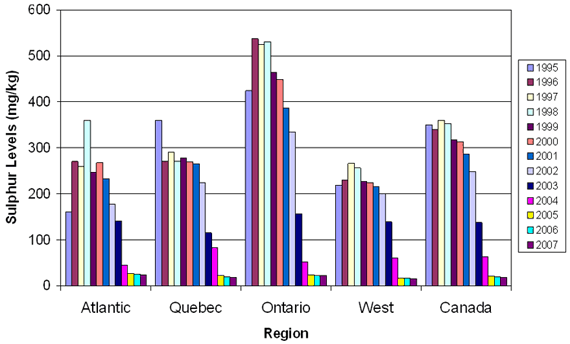
Click here to see the picture in full-size
The lower sulphur levels beginning in 2005 result from the Sulphur in Gasoline Regulations, which came into effect in 2002. The regulations set an average limit of 30 mg/kg commencing in 2005, with an interim limit of 150 mg/kg until then. Graph 1.2 shows the trends in the levels of sulphur in gasoline from 1999 to 2007.
Graph 1.2: National and Regional Trends of Sulphur Content in Gasoline 1999–2007
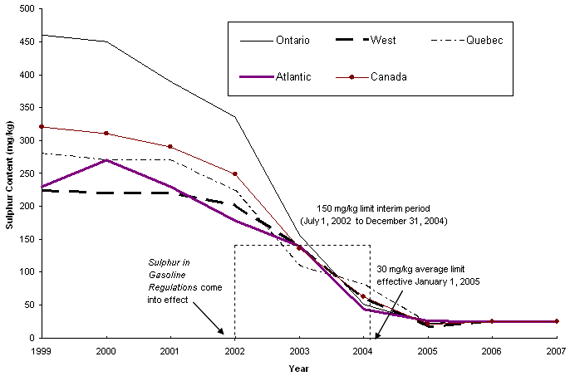
Click here to see the picture in full-size
The reported mass of sulphur content in all liquid fuels nationally decreased by 4% in 2007 from 2006 values, as shown in Graph 1.3. In the West Region, the reported mass of sulphur in all liquid fuels increased by 3% for 2007, mainly due to an increase in the production and importation of Aviation Turbo Fuel and Heavy Fuel Oil in that region. In the Atlantic, Ontario, and Quebec Region, the decreases were 10%, 1% and 1% respectively.
Graph 1.3: Sulphur Mass in Liquid Fuels by Region and Nationally, 1996-2007
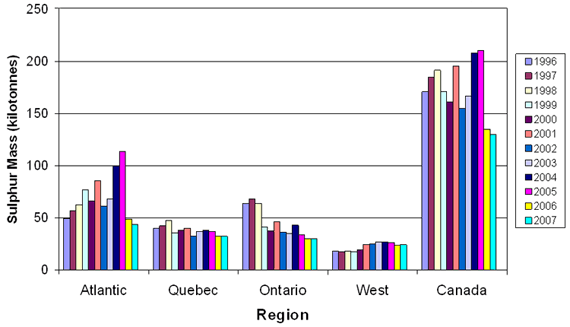
Click here to see the picture in full-size
Table 1.1 shows the national summary of data compiled from Form 1, “Report on Sulphur Content,” which petroleum refineries and importing companies are required to submit to Environment Canada under the Fuels Information Regulations, No. 1.
The largest reported volume of liquid fuel produced in or imported into Canada was gasoline,which constituted about 45% of all products, and accounted for about 0.4% of the sulphur mass in liquid fuels. Heavy fuel oil constituted about 8% by volume of the total liquid fuels and contained about 86% of the total sulphur mass in Canada.
Table 1.1: Fuel Production/Imports and Sulphur Content
| National Summary for 2007 |
| Type of Fuel |
Fuel Production/Imports |
Sulphur Mass
(tonnes) |
Average Sulphur Content
(mg/kg) |
Distribution of Sulphur in Products (%) |
| (m3) |
(% of total) |
- In the Type of Fuel category, “Plant Consumption” and “Other” were combined for 2007. Fuels reported under these categories included pitch, gasoline-like blendstock, light fuel oil, heavy fuel oil, Orimulsion, intermediate fuel oils (IFO 420, IFO 30-460), diesel and bunker.
- Totals may not add up due to rounding.
|
| Aviation Turbo Fuel |
6 695 902 |
7.20 |
3 148 |
581 |
2.42 |
| Motor Gasoline |
41 452 001 |
44.55 |
528 |
18 |
0.41 |
| Aviation Gasoline |
98 055 |
0.11 |
2 |
27 |
0.00 |
| Kerosene/Stove oil |
958 259 |
1.03 |
53 |
67 |
0.04 |
| Ultra-Low Sulphur Diesel |
29 049 870 |
31.22 |
102 |
4 |
0.08 |
| Low-Sulphur Diesel Fuel |
2 760 413 |
2.97 |
532 |
226 |
0.41 |
| High-Sulphur Diesel |
891 910 |
0.96 |
1 253 |
1 631 |
0.96 |
| Light Fuel Oil |
2 521 716 |
2.71 |
2 998 |
1 393 |
2.30 |
| Heavy Fuel Oil |
7 566 589 |
8.13 |
111 808 |
14 831 |
85.91 |
| Plant Consumption/Other |
1 042 582 |
1.12 |
9 716 |
9 237 |
7.47 |
| Total |
93,037,297 |
100.00 |
130,140 |
1,422 |
100.00 |
Top of Page
2.0 Introduction
2.1 Fuels Information Regulations, No. 1
The Fuels Information Regulations, No. 1 (see Appendix 2) were adopted in 1978 to provide Environment Canada with information on liquid fuel composition, particularly regarding sulphur dioxide (SO2) emissions from combustion. The Regulations require annual reporting on sulphur levels in fuels and one-time reporting of non-lead fuel additive content (additional reporting is required when there are changes). They apply to all fuels[1] in liquid form that originate from crude oils, coal or bituminous sands.
The Regulations require all producers and importers handling more than 400 cubic metres (m3) of fuels intended for consumption in Canada within a calendar year to report the volume of fuels produced or imported, the fuel density and the fuel sulphur content for each quarter of the calendar year (see Appendix 2). Environment Canada uses the reported values to estimate the mass of sulphur in Canadian fuels. The types of liquid fuel that are to be reported are shown in Appendix 2. The Regulations also require all producers and importers who supply more than 400 m3 of a fuel to report all the additives other than lead or lead compounds in the fuels.
The full text of the Fuels Information Regulations, No. 1 and reporting forms are available at: http://www.ec.gc.ca/energie-energy/default.asp?lang=En&n=3A2A9F94-1.
Top of Page
2.2 Regulations and Other Measures to Address Sulphur Levels in Fuels
Sulphur in Diesel Fuel Regulations
The federal Sulphur in Diesel Fuel Regulations set maximum limits for sulphur in on-road, off-road, rail (locomotive) and marine (vessel) diesel fuels. The production, import and sales limits and effective dates of the regulations are summarized in Table 2.1. The timing and limits are aligned with those of the U.S.
Table 2.1 Limits on Sulphur in Diesel Fuel and Effective Dates
| Sulphur Limit (mg/kg) |
On-Road Diesel Fuel |
Off-Road Diesel Fuel |
Rail and Marine Diesel Fuel |
|
1 September 1, 2007, in the Northern Supply Area, which is defined as the area corresponding to the following geographical areas: a) that part of the Yukon that is north of latitude 67° N; b) the Northwest Territories, except those areas within 1 km of the centre line of highways 2 to 7, and that portion of Hwy 1 south of Fort Simpson, and those areas within the municipalities of Yellowknife, Detah, Hay River, NWT, Fort Simpson, Rae, Edzo, Entreprise, Fort Resolution, Fort Smith and Fort Liard; c) Nunavut; d) those parts of Manitoba, Ontario and Quebec within 50 km from the coast of Hudson Bay or James Bay; e) that part of Quebec north of latitude 51° N if west of longitude 63.5° W, and north of latitude 50° N if east of longitude 63.5° W; and f) Newfoundland and Labrador, except the island of Newfoundland.
2 December 1, 2008, in the Northern Supply Area.
3 December 1, 2011, in the Northern Supply Area. |
| 500 |
Production or Import |
Since 1998 |
June 1, 2006 |
June 1, 2006 |
| Sales |
Since 1998 |
October 1, 20072 |
October 1, 20072 |
| 22 |
Sales |
September 1, 2006 |
N/A |
N/A |
| 15 |
Production or Import |
June 1, 2006 |
June 1, 2010 |
June 1, 2012 |
| Sales |
October 15, 20061 |
October 1, 20103 |
N/A |
Note that there is no volume threshold for reporting under the Sulphur in Diesel Fuel Regulations. The full text of the Sulphur in Diesel Fuel Regulations including amendments, along with the associated regulatory impact analysis statement and reporting forms, are available through Environment Canada’s Diesel Fuel Web site: http://www.ec.gc.ca/energie-energy/default.asp?lang=En&n=7A8F92ED-1.
Sulphur in Gasoline Regulations
On June 23, 1999, the federal government passed regulations limiting the amount of sulphur in gasoline. The Sulphur in Gasoline Regulations limit the sulphur content in gasoline to an average of 30 mg/kg with a maximum of 80 mg/kg starting January 1, 2005. An interim period beginning July 1, 2002, limited the average sulphur content of gasoline to 150 mg/kg over a two-and-a-half year period.
The full text of the Sulphur in Gasoline Regulations along with the associated regulatory impact analysis statements and reporting forms are available through Environment Canada’s Gasoline Web site: http://www.ec.gc.ca/energie-energy/default.asp?lang=En&n=BEA13229-1.
Canadian General Standards Board
The Canadian General Standards Board (CGSB) sets commercial standards for fuels, including some that have been adopted by provincial regulations. The standards for sulphur in fuels vary considerably among fuels (see Appendix 4). CGSB standards are revised periodically to reflect developments in product, usage and manufacturing technology.
Setting Canadian Standards for Fuel Oils Used in Stationary Sources
In the Notice of Intent on Cleaner Vehicles, Engines and Fuels, published in the Canada Gazette in February 2001, Environment Canada proposed the development of measures to reduce the level of sulphur in both light and heavy fuel oils used in stationary sources, with a view to matching the requirements set by the European Union (i.e. 1% by weight for heavy fuel oil and 0.1% by weight for light fuel oil, to be fully implemented by 2008). To this end, Environment Canada released a Discussion Paper in April 2003 and conducted a multi-stakeholder workshop in May 2003. Complementary measures such as economic instruments have also been examined. Work undertaken by the National Round Table on the Economy and the Environment (NRTEE) in 2003 involved studying the environmental and economic implications of using fiscal instruments to reduce sulphur levels in light and heavy fuel oil.
More information is available at: http://www.ec.gc.ca/Publications/default.asp?Lang=En&xml=7EE205D5-9F0E-449B-A598-29F675D620E4&edit=off.
Low Sulphur Procurement Guide
In June 2003, Environment Canada and Friends of the Earth jointly produced a Low Sulphur Fuels Procurement Guide aimed at encouraging governments and other organizations to take a leadership role in procuring low sulphur fuels, where possible. It provides a checklist of suggested low sulphur fuel procurement practices, contracting recommendations, suggestions for estimating emissions reductions, case studies, and links to key sources of information.
The Guide is available at: http://www.ec.gc.ca/Publications/default.asp?lang=En&xml=7474E70F-6F52-4D45-B4A3-B40E47586E31.
Top of Page
2.3 Period Covered
This report covers the period from January 1 to December 31, 2007. Under the Fuels Information Regulations, No. 1, petroleum refineries and importing companies are required to submit information, for each quarter of the calendar year, to Environment Canada on or before January 31 of the following year. The Sulphur in Diesel Fuel Regulations also require quarterly reports on the level of sulphur in diesel fuel with sulphur concentrations exceeding 500 mg/kg, between 500 mg/kg and 15 mg/kg and equal or less than 15 mg/kg. The Sulphur in Gasoline Regulations require annual reporting on the level of sulphur in gasoline.
Failure to submit the data on time, incomplete data or unsigned forms are offences under the Canadian Environmental Protection Act, 1999.
Top of Page
2.4 Reporting Petroleum Refineries and Importing Companies
Table 2.2 lists the petroleum refineries, blenders, and upgrading plants that reported, under the three regulations, information pertaining to production volume and fuel sulphur content for 2007.
Table 2.2 Refineries, Blenders and Importers reporting under the respective Regulations
| Company |
Location |
Prov. |
FIR1 |
Gasoline2 |
Diesel3 |
X = Report received; NP = Reported No Production.
1 Fuels Information Regulations, No. 1.
2 Sulphur in Gasoline Regulations.
3 Sulphur in Diesel Fuel Regulations.
|
| Biox Canada |
Hamilton |
ON |
|
|
X |
| Chevron Canada Limited |
Burnaby |
BC |
X |
X |
X |
| Consumers’ Co-operative Refineries Limited |
Regina |
SK |
X |
X |
X |
| Husky Oil Operations Ltd. |
Prince George |
BC |
X |
X |
X |
| Imperial Oil |
Dartmouth |
NS |
X |
X |
X |
| Imperial Oil |
Edmonton |
AB |
X |
X |
X |
| Imperial Oil |
Nanticoke |
ON |
X |
X |
X |
| Imperial Oil |
Sarnia |
ON |
X |
X |
X |
| Irving Oil Limited |
Saint John |
NB |
X |
X |
X |
| Milligan Biotech |
Foam Lake |
SK |
|
|
X |
| Newalta |
Vancouver |
BC |
X |
|
X |
| North Atlantic Refining Limited |
Come-by-Chance, NL |
NS |
X |
X |
X |
| NOVA Chemicals Canada Limited |
Corunna |
ON |
X |
|
X |
| Ocean Nutrition |
Mulgrave |
NS |
|
|
X |
| Petro-Canada |
Edmonton |
AB |
X |
X |
X |
| Petro-Canada |
Montréal |
QC |
X |
X |
X |
| Petro-Canada |
Oakville |
ON |
NP |
|
NP |
| Petro-Canada |
Ottawa |
ON |
|
|
NP |
| Petro-Canada |
Thunder Bay |
ON |
|
|
NP |
| Petro-Canada |
Port Moody |
BC |
X |
|
X |
| Petro-Canada Lubricants |
Mississauga |
ON |
X |
NP |
X |
| Rothsay |
Sainte-Catherine |
QC |
|
|
X |
| Shell Canada Products |
Edmonton |
AB |
|
NP |
|
| Shell Canada Products |
Corunna, |
ON |
X |
X |
X |
| Shell Canada Products |
Fort Saskatchewan |
AB |
X |
X |
X |
| Shell Canada Products |
Montréal |
QC |
X |
X |
X |
| Suncor Energy Products Incorporated |
Fort McMurray |
AB |
X |
|
X |
| Suncor Energy Products Incorporated |
Sarnia |
ON |
X |
X |
X |
| Syncrude Canada Ltd. |
Fort McMurray |
AB |
X |
|
X |
| Ultramar Limitée |
Lévis/Saint-Romuald |
QC |
X |
X |
X |
| Ultramar Limitée |
Montréal |
QC |
X |
X |
|
The following petroleum importers reported, under the three regulations, information pertaining to import volume and fuel sulphur content for 2007.
Table 2.3 Importers Reporting under the Respective Regulations
| Company |
Location |
Province |
FIR1 |
Gasoline2 |
Diesel3 |
X = Report received; NI = Reported No Imports.
1 Fuels Information Regulations, No. 1.
2 Sulphur in Gasoline Regulations.
3 Sulphur in Diesel Fuel Regulations.
|
| Air Canada |
Westridge |
BC |
X |
|
|
| Air Canada |
Beauport |
QC |
X |
|
|
| Air Canada (Vopak) |
Hamilton |
ON |
X |
|
|
| BP Cherry Point |
Vancouver |
BC |
X |
|
|
| Canada Clean Fuels |
Toronto |
ON |
|
|
X |
| Canadian National Railway |
Surrey |
BC |
|
|
X |
| Canadian Pacific Railway |
Calgary |
AB |
NI |
|
|
| Catalyst Paper Corporation (Norske Canada) |
Campbell River |
BC |
X |
|
|
| Catalyst Paper Corporation (Norske Canada) |
Crofton |
BC |
X |
|
|
| Cervini Farms |
Leamington |
ON |
X |
|
|
| Chevron Canada Limited |
Burnaby |
BC |
X |
X |
X |
| Compagnie Minière Québec Cartier |
Port Cartier |
QC |
X |
|
|
| Consumers’ Co-operative Refineries Limited |
Regina |
SK |
|
|
X |
| Daigle Oil |
Edmundston |
NB |
X |
|
|
| Ford Motor Company of Canada |
Windsor |
ON |
|
|
X |
| General Motors Canada |
Ontario |
ON |
|
X |
X |
| Great Lakes Greenhouses Inc |
Leamington |
ON |
X |
|
|
| Honda of Canada Mfg. |
Queenston |
ON |
|
X |
|
| Imperial Oil |
B.C. Imports |
BC |
|
|
X |
| Imperial Oil |
Burnaby |
BC |
X |
X |
|
| Imperial Oil |
Calgary, |
BC |
|
|
X |
| Imperial Oil |
Dartmouth |
NS |
X |
|
|
| Imperial Oil |
Halifax |
NS |
X |
|
|
| Imperial Oil |
Nanticoke |
ON |
|
X |
|
| Imperial Oil |
N.S. Imports |
NS |
|
|
X |
| Imperial Oil |
Point Tupper |
NS |
X |
X |
|
| Imperial Oil |
Québec |
QC |
X |
|
X |
| Imperial Oil |
Sarnia |
ON |
|
X |
|
| Imperial Oil |
Sept Isles |
QC |
X |
|
|
| Irving Oil Limited |
Saint John |
NB |
X |
X |
|
| Kildair Services Ltée |
Tracy |
QC |
X |
|
|
| Mackenzie Petroleum Limited |
Dawson City |
YT |
X |
|
X |
| Marine Petrobulk Limited |
Vancouver |
BC |
X |
|
X |
| New Brunswick Power Corporation |
Fredericton |
NB |
X |
|
|
| Newfoundland & Labrador Hydro |
St. John’s |
NFL |
X |
|
|
| Nexfor Fraser Papers Incorporated |
Edmundston |
NB |
X |
|
|
| North Atlantic Refining Limited |
Come-by-Chance |
NS |
X |
|
|
| Northern Transportation Company Limited |
Hay River |
NWT |
X |
|
X |
| Northland Biodiesel Marketing Inc. |
Thunder Bay |
ON |
|
|
X |
| Nova Scotia Power |
Halifax |
NS |
X |
|
|
| Olco Petroleum Group |
Beauport |
QC |
X |
X |
|
| Ontario Limited |
Leamington |
ON |
X |
|
|
| Parkland Refineries Limited |
Y.T. Imports |
YT |
X |
|
X |
| Petro-Canada |
Montréal |
QC |
X |
X |
|
| Petro-Canada |
Port Moody |
BC |
X |
X |
X |
| Pétroles Norcan |
Montréal |
QC |
X |
X |
X |
| Pope and Talbot Limited |
Nanaimo |
BC |
X |
|
|
| Port Colborne Quarries Limited |
Port Colborne |
ON |
X |
|
|
| Shell Canada Products |
Montréal |
QC |
X |
X |
|
| Shell Canada Products |
Burnaby |
BC |
X |
|
X |
| Suncor Energy Products Incorporated |
Sarnia |
ON |
X |
X |
X |
| Sylvite Sales Inc. |
Burlington |
ON |
|
|
X |
| Ultramar Limitée |
Halifax |
NS |
|
|
NI |
| Ultramar Limitée |
Holyrood |
NL |
|
NI |
NI |
| Ultramar Limitée |
Lévis/Saint-Romuald |
QC |
X |
X |
X |
| Ultramar Limitée |
Montréal |
QC |
X |
X |
X |
| Western Gas and Liquids Company |
Ontario Imports |
ON |
|
|
X |
Top of Page
2.5 Company-Specific Sulphur Levels
Appendix 3 presents data on the annual volume-weighted sulphur content (in mg/kg) for gasoline, diesel fuel and fuel oil during the period 1995 to 2007 for each Canadian refinery and importer.
Top of Page
3.0 Volumes of Liquid Fuels Produced/Imported
In order to verify their accuracy, the reported volumes of produced fuels were compared to Statistics Canada figures for 2007 (see Table 3.1).
With the exception of “Kerosene/Stove Oil,” and “Plant Consumption/Other,” there appears to be reasonable agreement between the two sets of data. This may result from the different approaches used, as noted below.
Table 3.1 Volumes of Liquid Fuels Produced / Imported for Sale in Canada
| Reported to Statistics Canada (1) and Environment Canada for 2007 |
| Type of Fuel |
Statistics Canada
(m3) |
Environment Canada
(m3) |
Source: Statistics Canada, Catalogue No. 45-004-XIE monthly, January 2008.
1 Statistics Canada data were compiled for the year 2007.
2 Statistics Canada does not differentiate between the sulphur level of diesel fuel, that is, ultra-low-sulphur, low-sulphur and regular sulphur diesel grades in regards to production. All diesel fuel produced or imported in Canada is under the “Diesel Fuel” category.
Notes:
- According to Statistics Canada, approximately 75–80% of refinery-produced kerosene and stove oil are later transferred to diesel and light fuel oils.
- Statistics Canada does not distinguish between ultra-low-sulphur, low-sulphur and regular sulphur diesel grades in regards to production.
- Volumes reported to Environment Canada mostly reflect production at the various refineries while Statistics Canada considers opening and closing inventories and inter-product transfers.
- Plant consumption is listed as “Own Consumption” in the Statistics Canada report. This covers the whole range of petroleum products listed in the Statistics Canada publication. Statistics Canada defined “Own Consumption” as the amount of petroleum product produced or purchased and used in refinery operations. Environment Canada volumes reported under “Plant Consumption” included pitch, gasoline-like blendstock, light fuel oil, heavy fuel oil, Orimulsion, intermediate fuel oils (IFO 420, IFO 30-460), and diesel. The Environment Canada quarterly report Form 1 does not list “Plant Consumption” as a liquid fuel to report, although it has been historically reported by some companies.
- Statistics Canada’s “Other Petroleum Products” is defined as all other petroleum products such as wax and candles, unfinished products, etc. The “Other” category under the Fuels Information Regulations, No. 1 includes bunker.
- Totals may not add up due to rounding and volumes not included.
|
| Aviation Turbo Fuel |
6,862,800 |
6,695,902 |
| Motor/Aviation Gasoline |
42,538,600 |
41,550,056 |
| Kerosene/Stove oil |
289,400 |
958,259 |
| Ultra-Low Sulphur Diesel Fuel |
N/A2 |
29,049,870 |
| Low Sulphur Diesel Fuel |
N/A2 |
2,760,413 |
| Diesel Fuel |
27,669,100 |
891,910 |
| Light Fuel Oil |
4,355,300 |
2,521,716 |
| Heavy Fuel Oil |
6,003,000 |
7,566,589 |
| Plant Consumption/Other |
5,675,393 |
1,042,582 |
| Total |
93,393,593 |
93,037,297 |
Top of Page
4.0 Volumes of Liquid Fuels Produced/Imported and Fuel Sulphur Content
4.1 National and Regional Summaries
The following graphs and tables summarize the data compiled from reports submitted pursuant to the Fuels Information Regulations, No. 1 for 2007:
- National Data for Liquid Fuels: Table 4.1, Graphs 4.1 and 4.2
- Regional Data for Liquid Fuels: Tables 4.2A to E, Graphs 4.3 and 4.4
- Regional Data for Motor/Aviation Gasoline: Graph 4.5
- Refinery Data for Motor Gasoline: Graph 4.6
- Refinery Data for Diesel Fuel: Graphs 4.7 and 4.9
- Historical Trends (National): Graphs 4.10 to 4.15
Table 4.1 Fuel Production / Imports and Sulphur Content
| National Summary for 2007 |
| Type of Fuel |
Fuel Production / Imports |
Sulphur
Mass (tonnes) |
Average
Sulphur
Content
(mg/kg) |
Distribution of Sulphur in Products (%) |
| (m3) |
(% of total) |
| Totals may not add up due to rounding. |
| Aviation Turbo Fuel |
6,695,902 |
7.20 |
3,148 |
581 |
2.42 |
| Motor Gasoline |
41,452,001 |
44.55 |
528 |
18 |
0.41 |
| Aviation Gasoline |
98,055 |
0.11 |
2 |
27 |
0.00 |
| Kerosene/Stove oil |
958,259 |
1.03 |
53 |
67 |
0.04 |
| Ultra Low-Sulphur Diesel |
29,049,870 |
31.22 |
102 |
4 |
0.08 |
| Low-Sulphur Diesel Fuel |
2,760,413 |
2.97 |
532 |
226 |
0.41 |
| High-Sulphur Diesel Fuel |
891,910 |
0.96 |
1,253 |
1,631 |
0.96 |
| Light Fuel Oil |
2,521,716 |
2.71 |
2,998 |
1,393 |
2.30 |
| Heavy Fuel Oil |
7,566,589 |
8.13 |
111,808 |
14,831 |
85.91 |
| Plant Consumption/Other |
1,042,582 |
1.12 |
9,716 |
9,237 |
7.47 |
| Total |
93,037,297 |
100.00 |
130,140 |
1,422 |
100.00 |
Graph 4.1: National Liquid Fuel Production/Imports in 2007
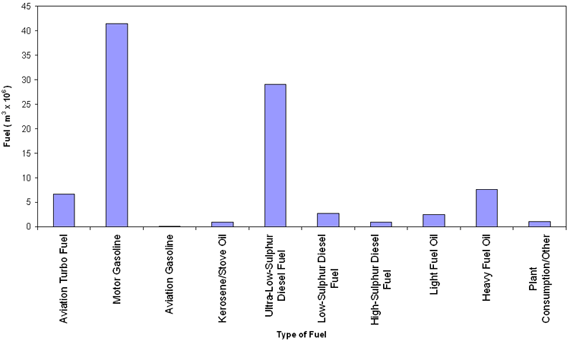
Click here to see the picture in full-size
Graph 4.2: Tonnage of Sulphur in Liquid Fuels in 2007
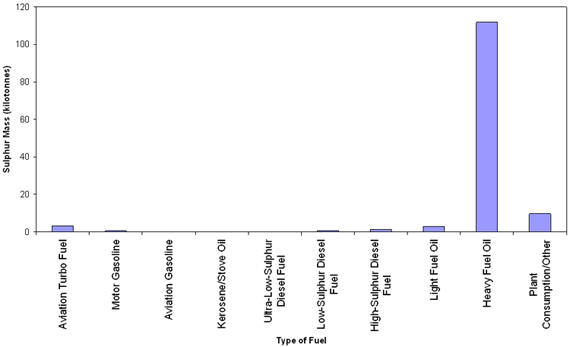
Click here to see the picture in full-size
Table 4.2A Fuel Production/Imports and Sulphur Content, Atlantic Region Summary for 2007
| Atlantic Region |
| Type of Fuel |
Fuel Production / Imports
(m3) |
Sulphur Mass
(tonnes) |
Average Sulphur Content
(mg/kg) |
Distribution of Sulphur in Products
(%) |
1. Volume not included to protect confidential data
2. Total volume excludes the volume not included, as per 1.
3. “Plant Consumption” in the Atlantic Region consists mostly of pitch, gasoline-like blendstock, intermediate fuel oil, and light/heavy fuel oil. “Other” consists of bunker and bituminous emulsion product (i.e. Orimulsion).
|
| Aviation Turbo Fuel |
515,257 |
625 |
1,511 |
1.42 |
| Motor Gasoline |
NA1 |
49 |
23 |
0.11 |
| Aviation Gasoline |
0 |
0 |
0 |
0.00 |
| Kerosene/Stove oil |
47,559 |
29 |
746 |
0.07 |
| Ultra Low-Sulphur Diesel Fuel |
1,861,823 |
8 |
5 |
0.02 |
| Low-Sulphur Diesel Fuel |
186,612 |
51 |
321 |
0.12 |
| Diesel Fuel |
NA1 |
190 |
1,517 |
0.43 |
| Light Fuel Oil |
1,268,304 |
1,724 |
1,583 |
3.92 |
| Heavy Fuel Oil |
2,261,345 |
36,652 |
16,224 |
83.46 |
| Plant Consumption/Other3 |
352,856 |
4,596 |
13,247 |
10.47 |
| Total |
6,493,7552 |
43,923 |
35,177 |
100 |
Top of Page
Table 4.2B Fuel Production/Imports and Sulphur Content, Québec Region Summary for 2007
| Québec Region |
| Type of Fuel |
Fuel Production / Imports
(m3) |
Sulphur Mass
(tonnes) |
Average Sulphur Content
(mg/kg) |
Distribution of Sulphur in Products (%) |
1. Volume not included to protect confidential data
2. Total volume excludes the volume not included, as per 1.
3. “Plant Consumption” in Quebec consists mostly of heavy fuel oil and unspecified fuel.
|
| Aviation Turbo Fuel |
1,825,182 |
954 |
646 |
2.95 |
| Motor Gasoline |
14,641,069 |
200 |
19 |
0.62 |
| Aviation Gasoline |
NA1 |
0 |
3 |
0.00 |
| Kerosene/Stove oil |
792,613 |
3 |
4 |
0.01 |
| Ultra Low-Sulphur Diesel Fuel |
7,624,819 |
22 |
4 |
0.07 |
| Low-Sulphur Diesel Fuel |
21,120 |
1 |
60 |
0.00 |
| Diesel Fuel |
NA1 |
0 |
0 |
0.00 |
| Light Fuel Oil |
979,907 |
1,104 |
1,331 |
3.42 |
| Heavy Fuel Oil |
2,802,246 |
30,030 |
10,867 |
93.00 |
| Plant Consumption/Other3 |
NA1 |
0 |
0 |
0.00 |
| Total |
28,686,7572 |
32,314 |
12,933 |
100 |
Table 4.2C Fuel Production/Imports and Sulphur Content, Ontario Region Summary for 2007
| Ontario Region |
| Type of Fuel |
Fuel Production / Imports
(m3) |
Sulphur Mass
(tonnes) |
Average Sulphur Content
(mg/kg) |
Distribution of Sulphur in Products (%) |
| 1. Plant consumption in Ontario consists mostly of liquefied refinery fuel (LRF) and heavy fuel oil and unspecified fuels. |
| Aviation Turbo Fuel |
1,230,097 |
526 |
527 |
1.77 |
| Motor Gasoline |
10,339,693 |
136 |
22 |
0.46 |
| Aviation Gasoline |
0 |
0 |
0 |
0.00 |
| Kerosene/Stove oil |
54,270 |
21 |
458 |
0.07 |
| Ultra Low-Sulphur Diesel Fuel |
5,569,382 |
22 |
5 |
0.07 |
| Low-Sulphur Diesel Fuel |
355,708 |
102 |
334 |
0.34 |
| Diesel Fuel |
217,171 |
369 |
1,938 |
1.24 |
| Light Fuel Oil |
259,763 |
135 |
624 |
0.46 |
| Heavy Fuel Oil |
1,228,198 |
23,394 |
19,063 |
78.72 |
| Plant Consumption/Other1 |
266,307 |
5,034 |
18,222 |
16.94 |
| Total |
19,520,589 |
29,739 |
41,193 |
100 |
Table 4.2D Fuel Production/Imports and Sulphur Content, West Region Summary for 2007
| West Region |
| Type of Fuel |
Fuel Production / Imports
(m3) |
Sulphur Mass
(tonnes) |
Average Sulphur Content
(mg/kg) |
Distribution of Sulphur in Products (%) |
1. Volume not included to protect confidential data
2. Total volume excludes the volume not included, as per 1.
3. Plant consumption in the West Region—i.e. MB, SK, AB, BC, YT, NWT, and NU—consists mostly of diesel fuels and unspecified fuels.
|
| Aviation Turbo Fuel |
3,125,366 |
1,044 |
412 |
4.33 |
| Motor Gasoline |
13,542,599 |
142 |
14 |
0.59 |
| Aviation Gasoline |
NA1 |
2 |
47 |
0.01 |
| Kerosene/Stove oil |
NA1 |
0 |
3 |
0.00 |
| Ultra Low-Sulphur Diesel Fuel |
13,993,846 |
50 |
4 |
0.21 |
| Low-Sulphur Diesel Fuel |
2,196,974 |
378 |
203 |
1.57 |
| Diesel Fuel |
528,104 |
695 |
1,537 |
2.87 |
| Light Fuel Oil |
NA1 |
36 |
2,839 |
0.15 |
| Heavy Fuel Oil |
1,274,799 |
21,732 |
16,996 |
90.12 |
| Plant Consumption/Other3 |
392,984 |
86 |
263 |
0.36 |
| Total |
35,054,6722 |
24,164 |
22,318 |
100 |
Table 4.2E National Volume Weighted Averages of the Density of Fuels Produced And Imported in 2007 (kg/m3)
| Type of Fuel |
National Volume Weighted Average Density (kg/m3) |
| Aviation Turbo Fuel |
810.5 |
| Motor Gasoline |
733.1 |
| Aviation Gasoline |
703.5 |
| Kerosene/Stove oil |
818.2 |
| Ultra Low-Sulphur Diesel Fuel |
837.4 |
| Low-Sulphur Diesel Fuel |
846.4 |
| Diesel Fuel |
858.1 |
| Light Fuel Oil |
847.6 |
| Heavy Fuel Oil |
993.8 |
| Plant Consumption/Other |
899.3 |
Top of Page
Graph 4.3: Mass of Sulphur in Liquid Fuels Produced/Imported in 2007
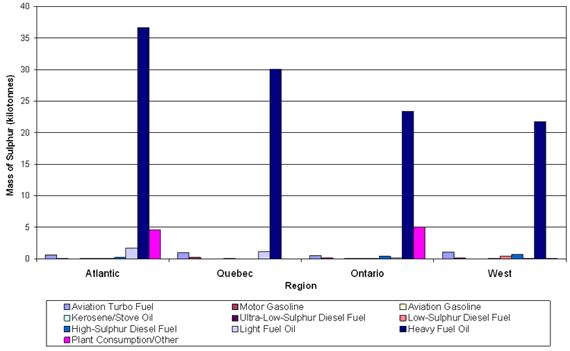
Click here to see the picture in full-size
Graph 4.4: Sulphur Mass in Liquid Fuels by Region and Nationally, 1996–2007
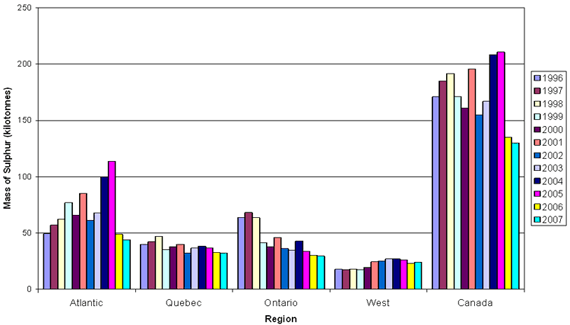
Click here to see the picture in full-size
Graph 4.5: Average Sulphur Levels in Motor/Aviation Gasoline by Region and Nationally, 1995–2007
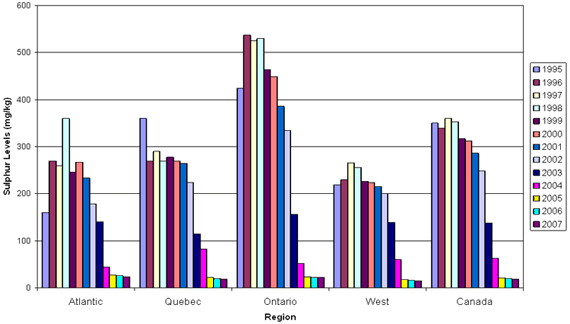
Click here to see the picture in full-size
Graph 4.6: Average Sulphur Levels in Motor Gasoline by Refinery/Importer in 2007
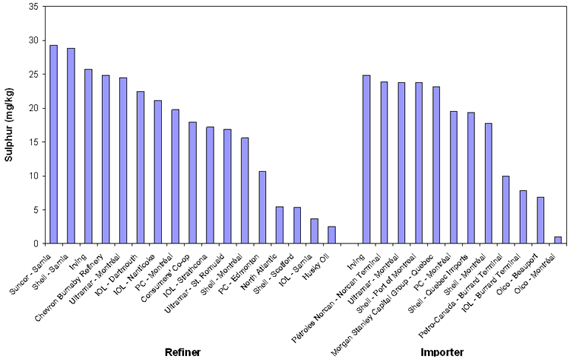
Click here to see the picture in full-size
Graph 4.7: Average Sulphur Levels in Ultra-Low-Sulphur Diesel Fuel by Refinery/Importer in 2007
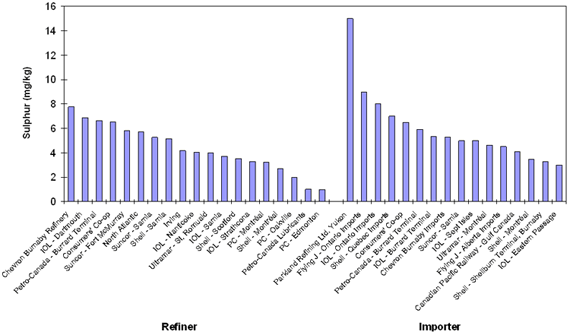
Click here to see the picture in full-size
Graph 4.8: Average Sulphur Levels in Low-Sulphur Diesel Fuel by Refinery/Importer in 2007
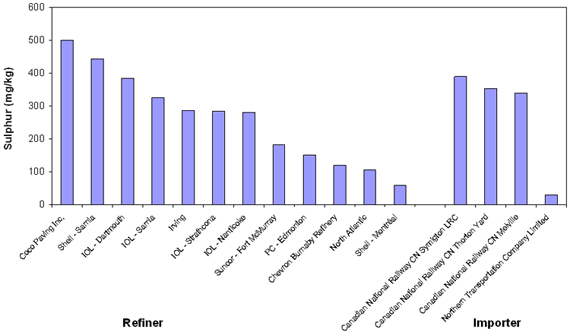
Click here to see the picture in full-size
Graph 4.9: Average Sulphur in High-Sulphur Diesel Fuel by Refinery/Importer in 2007
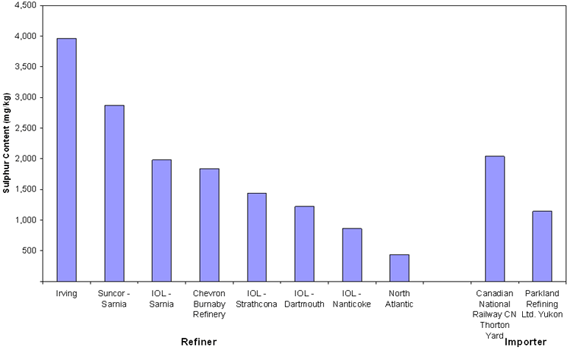
Click here to see the picture in full-size
Top of Page
Graph 4.10: National Trend of Sulphur Content in Aviation Turbo Fuel, 1995-2007
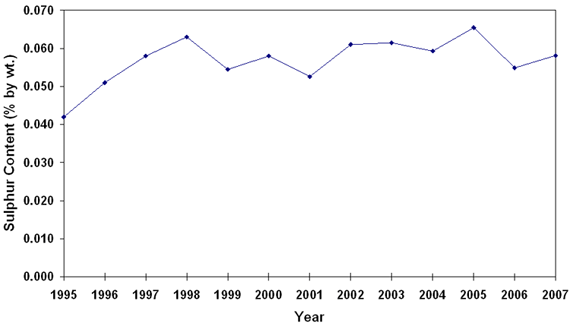
Click here to see the picture in full-size
Graph 4.11: National Trend of Sulphur Content in Motor/Aviation Gasoline, 1995-2007
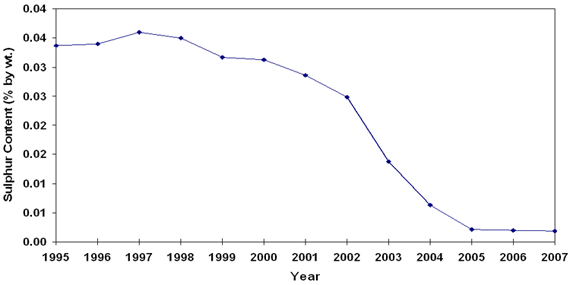
Click here to see the picture in full-size
Graph 4.12: National Trend of Sulphur Content in Kerosene/Stove Oil, 1995-2007
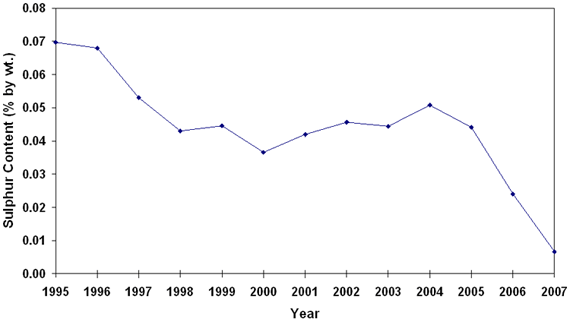
Click here to see the picture in full-size
Graph 4.13: National Trend of Sulphur Content in Diesel Fuel (Total Pool), 1995-2007
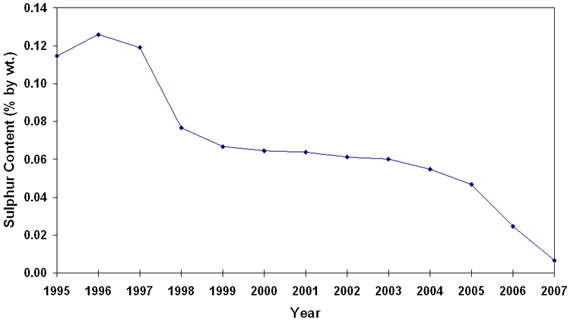
Click here to see the picture in full-size
Graph 4.14: National Trend of Sulphur Content in Light Fuel Oil, 1995-2007
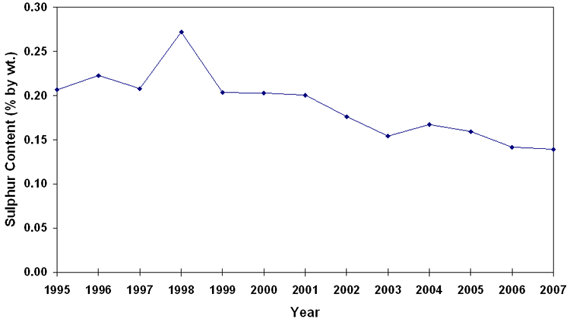
Click here to see the picture in full-size
Graph 4.15: National Trend of Sulphur Content in Heavy Fuel Oil, 1995-2007
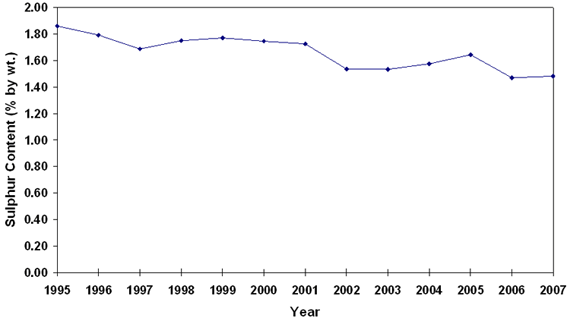
Click here to see the picture in full-size
Top of Page
Appendix 1
Web Site References for Fuels Information Regulations, No. 1 and Other Fuels Regulations
Environment Canada’s Fossil Fuels – Home Page
Fuels Information Regulations, No. 1
Sulphur in Gasoline Regulations
Benzene in Gasoline Regulations
Contaminated Fuels Regulations
Gasoline Regulations
Gasoline and Gasoline Blend Dispensing Flow Rate Regulations
Sulphur in Diesel Fuel Regulations
Top of Page
Appendix 2
Sample Forms for Reporting Sulphur Content under the Fuels Information Regulations, No. 1, Sulphur in Gasoline Regulations, and Sulphur in Diesel Fuel Regulations
(2007 Compliance Promotion Package)
FUELS INFORMATION REGULATIONS NO. 1
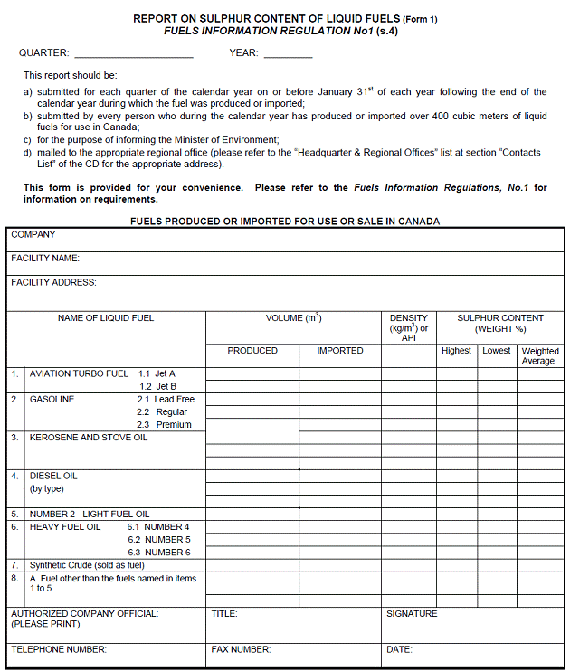
Click here to see the picture in full-size
SULPHUR IN DIESEL FUEL REGULATIONS
SCHEDULE 1
(Subsection 5(1))
QUARTERLY REPORT OF SULPHUR CONCENTRATION IN DIESEL FUEL
1. Calendar quarter ______________________________________________________________________
2. Year ______________________________________________________________________
3. Name of producer or importer
______________________________________________________________________
4. Name of the facility in Canada producing diesel fuel or the province of import
______________________________________________________________________
5. Street address (and mailing address if different) of the facility in Canada producing diesel fuel or of the importer’s place of business in Canada
______________________________________________________________________
______________________________________________________________________
______________________________________________________________________
6. Volume of diesel fuel, in m3, and sulphur concentration, in mg/kg
| |
Diesel Fuel Excluding Biodiesel Fuel and Blends of Biodiesel Fuel and Diesel Fuel |
Biodiesel Fuel |
Blends of Biodiesel Fuel and Diesel Fuel |
| (a) Diesel fuel with a concentration of sulphur that was less than or equal to 15mg/kg |
| (i) Volume of diesel fuel |
|
|
|
| (ii) Highest sulphur concentration |
|
|
|
| (iii) Lowest sulphur concentration |
|
|
|
| (iv) Volume-weighted average sulphur concentration |
|
|
|
| (v) Method used (for reporting purposes) to measure sulphur concentration |
|
|
|
| (b) Diesel fuel with a concentration of sulphur that exceeded 15mg/kg and was less than or equal to 500 mg/kg |
| (i) Volume of diesel fuel |
|
|
|
| (ii) Highest sulphur concentration |
|
|
|
| (iii) Lowest sulphur concentration |
|
|
|
| (iv) Volume-weighted average sulphur concentration |
|
|
|
| (v) Method used (for reporting purposes) to measure sulphur concentration |
|
|
|
| (c) Diesel fuel with a concentration of sulphur exceeding 500 mg/kg |
| (i) Volume of diesel fuel |
|
|
|
| (ii) Highest sulphur concentration |
|
|
|
| (iii) Lowest sulphur concentration |
|
|
|
| (iv) Volume-weighted average sulphur concentration |
|
|
|
| (v) Method used (for reporting purposes) to measure sulphur concentration |
|
|
|
7. Authorized official
Name ______________________________________________________________________
Title ______________________________________________________________________
Signature and date ______________________________________________________________________
Telephone number: (_____) ____________________
Fax number: (_____) ____________________
Top of Page
SULPHUR IN GASOLINE REGULATIONS (SOR/99-236)
ANNUAL REPORT ON VOLUMES AND SULPHUR LEVEL
SULPHUR IN GASOLINE REGULATIONS (s.4 & 6(2))
This report should be:
- submitted by each primary supplier that produces or imports gasoline identified as low-sulphur gasoline, California gasoline or gasoline-like blendstock as identified under section 5 of the Regulations,
- for each refinery and blending facility at which the primary supplier produced the gasoline, for each province into which it imported the gasoline and for each combination which it selected under section 9 of the Regulations,
- annually, on or before February 15 of the year following the year for which the report is prepared.
- mailed to the appropriate regional office (please refer to the “Headquarter & Regional Offices” list at section “Contacts List” of the CD for the appropriate address).
This form is provided for your convenience. Please refer to the Sulphur in Gasoline Regulations for information on compliance with the requirements for reporting on the sulphur content of liquid fuels.
Registration Number under the Benzene in Gasoline Regulations______________________________________________________________________
Year ______________________________________________________________________
Company name ______________________________________________________________________
Company address ______________________________________________________________________
Type of primary supplier (check one or more):
[ ] Producer at a refinery [ ] Producer at a blending facility [ ] Importer
Method selected to meet the sulphur limit: [ ] Pool average [ ] Flat
Name and location of the refinery, blending facility or points of importation in the province covered by this report:
| |
Annual Volume |
Flat Limit |
Pool Average |
| Type of Gasoline |
PRODUCED
(m3) |
IMPORTED
(m3) |
Maximum Sulphur Concentration in Gasoline (mg/kg) |
Maximum Sulphur Concentration in Gasoline (mg/kg) |
Volume-Weighted Average (mg/kg) |
| 1. Low Sulphur Gasoline |
|
|
|
|
|
| 2. California Gasoline |
|
|
|
NOT
REQUIRED |
NOT
REQUIRED |
| 3. Gasoline-like Blendstock |
|
|
NOT
REQUIRED |
NOT
REQUIRED |
NOT
REQUIRED |
Authorized Official ______________________________________________________________
Title ______________________________________________________________________
Telephone No. (_____) ____________________
Fax No. (_____) ____________________
Signature ______________________________________________________________________
Date ______________________________________________________________________
Contact Name ______________________________________________________________________
Contact Telephone No. (_____) ____________________
Top of Page
ADDRESSES OF ENVIRONMENT CANADA’S REGIONAL OFFICES
Newfoundland and Labrador, Nova Scotia, New Brunswick and Prince Edward Island
Director
Environmental Protection – Atlantic Region
Environment Canada
45 Alderney Drive
16th floor, Queens Square
Dartmouth, NS, Nova Scotia B2Y 2N6
Fax: (902) 426-4352
Quebec
Director
Environmental Enforcement Division
Enforcement Branch
105, McGill Street 7th Floor
Montréal, QC, Québec H2Y 2E7
Fax : (514) 496-2087
Ontario
Director, Environmental Enforcement-Ontario Region
Environment Canada
4905 Dufferin Street, Second floor
Toronto, Ontario, M3H 5T4
Fax: (416) 739-4251
Manitoba, Saskatchewan, Alberta, NWT and Nunavut
Regional Director
Environmental Enforcement Division
Enforcement Branch – Prairie & Northern Region
Environment Canada
Room 200
4999 - 98th Avenue NW
Edmonton, AB, Alberta T6B 2X3
Fax : (780) 495-2451
British Columbia and Yukon
Regional Manager
Environmental Enforcement Division
Enforcement Branch-Pacific & Yukon Region
Environment Canada
401 Burrard Street – suite 201
Vancouver, British Columbia V6C 3S5
Fax : (604) 666-9059
ADDRESS FOR ENVIRONMENT CANADA HEADQUARTERS
Fuels Section
Oil, Gas and Alternative Energy Division
Environment Canada
351 St. Joseph Blvd
Gatineau, QC, K1A 0H3
Fax : (819) 953-8903
Top of Page
Appendix 3
Volume-Weighted AnnualSulphur Levels by Refiner/Importer, 1995–2007
Appendix 3.1a: Volume Weighted Annual Sulphur Levels in Motor Gasoline 1995 – 2007
Click here for table
Appendix 3.1b: Volume Weighted Quarterly Sulphur Levels in Motor Gasoline for 2007
| |
Sulphur Levels (mg/kg) |
| |
Facility Name |
Location |
Q1 |
Q2 |
Q3 |
Q4 |
Annual |
| Refiner |
Chevron Canada Limited |
Burnaby, BC |
30 |
24 |
19 |
28 |
25 |
| Consumers' Co-operative Refineries Limited |
Regina, SK |
18 |
18 |
18 |
17 |
18 |
| Husky Oil Operations Ltd. |
Prince George, BC |
0 |
0 |
10 |
0 |
3 |
| Imperial Oil |
Dartmouth, NS |
18 |
28 |
22 |
21 |
22 |
| Imperial Oil |
Nanticoke, ON |
24 |
26 |
29 |
17 |
21 |
| Imperial Oil |
Sarnia, ON |
5 |
5 |
2 |
3 |
4 |
| Imperial Oil |
Edmonton, AB |
19 |
14 |
19 |
17 |
17 |
| Irving Oil Limited |
Saint-John, NB |
26 |
23 |
24 |
31 |
26 |
| North Atlantic Refining Limited |
Come-by-Chance, NL |
7 |
4 |
7 |
4 |
5 |
| Petro-Canada |
Edmonton, AB |
8 |
4 |
15 |
15 |
11 |
| Petro-Canada |
Montréal, QC |
21 |
22 |
18 |
18 |
20 |
| Shell Canada Products |
Montréal, QC |
18 |
14 |
14 |
17 |
16 |
| Shell Canada Products |
Corunna, ON |
26 |
21 |
31 |
37 |
29 |
| Shell Canada Products |
Fort Saskatchewan, AB |
7 |
6 |
5 |
3 |
5 |
| Suncor Energy Products Incorporated |
Sarnia, ON |
35 |
20 |
33 |
30 |
29 |
| Ultramar Limitée |
Montréal, QC |
28 |
30 |
20 |
23 |
25 |
| Ultramar Limitée |
Lévis // St-Romuald, QC |
13 |
19 |
16 |
19 |
17 |
| Importer |
Imperial Oil |
Burnaby, BC |
3 |
10 |
8 |
0 |
8 |
| Irving Oil Limited |
Saint-John, NB |
26 |
23 |
24 |
31 |
25 |
| Morgan Stanley Capital Group |
Purchase, NY |
0 |
20 |
27 |
6 |
23 |
| Olco Petroleum Group |
Beauport, QC |
27 |
2 |
0 |
0 |
7 |
| Olco Petroleum Group |
Montréal, QC |
0 |
1 |
0 |
0 |
1 |
| Petro-Canada |
Montréal, QC |
21 |
22 |
18 |
18 |
19 |
| Petro-Canada |
Port Moody, BC |
0 |
0 |
10 |
0 |
10 |
| Pétroles Norcan |
Montréal, QC |
30 |
13 |
32 |
18 |
24 |
| Shell Canada Products |
Montréal, QC |
18 |
14 |
14 |
17 |
18 |
| Shell Canada Products |
Port of Montreal, QC |
32 |
14 |
0 |
0 |
24 |
| Shell Trading Canada |
Quebec Imports, QC |
0 |
0 |
19 |
20 |
19 |
| Ultramar Limitée |
Montréal, QC |
28 |
30 |
20 |
23 |
24 |
| National Average |
19 |
18 |
20 |
17 |
18 |
Top of Page
Appendix 3.2a: Volume Weighted Annual Sulphur Levels in Ultra Low-Sulphur Diesel 2006 – 20071
| |
Sulphur Levels (mg/kg) |
| |
Facility Name |
Location |
2006 |
2007 |
| 1 No data for 1995-2005 as 15 mg/kg Sulphur limit for Ultra-Low Sulphur Diesel came into effect from 2006 (No Ultra- Low Sulphur Diesel data collected from 1999-2005) |
| Refiner |
Chevron Canada Limited |
Burnaby, BC |
9 |
8 |
| Consumers' Co-operative Refineries Limited |
Regina, SK |
6 |
7 |
| Imperial Oil |
Dartmouth, NS |
7 |
7 |
| Imperial Oil |
Edmonton, AB |
4 |
3 |
| Imperial Oil |
Nanticoke, ON |
4 |
4 |
| Imperial Oil |
Sarnia, ON |
4 |
4 |
| Irving Oil Limited |
Saint-John, NB |
4 |
4 |
| North Atlantic Refining Limited |
Come-by-Chance, NL |
5 |
6 |
| Petro-Canada |
Edmonton, AB |
2 |
1 |
| Petro-Canada |
Montréal, QC |
4 |
3 |
| Petro-Canada |
Oakville, ON |
- |
2 |
| Petro-Canada |
Port Moody, BC |
6 |
7 |
| Petro-Canada Lubricants |
Mississauga, ON |
1 |
1 |
| Shell Canada Products |
Corunna, ON |
4 |
5 |
| Shell Canada Products |
Fort Saskatchewan, AB |
3 |
4 |
| Shell Canada Products |
Montréal, QC |
5 |
3 |
| Suncor Energy Incorporated |
Fort McMurray, AB |
6 |
6 |
| Suncor Energy Products Incorporated |
Sarnia, ON |
5 |
5 |
| Ultramar Limitée |
Lévis // St-Romuald, QC |
3 |
4 |
| Importer |
Canadian Pacific Railway |
Calgary, AB |
- |
4 |
| Chevron Canada Limited |
Burnaby, BC |
7 |
5 |
| Flying J Inc |
Calgary, AB |
- |
5 |
| Flying J Inc |
London, ON |
- |
9 |
| Imperial Oil |
Burnaby, BC |
6 |
5 |
| Imperial Oil |
Halifax, NS |
5 |
3 |
| Imperial Oil |
Ontario Imports, ON |
- |
8 |
| Imperial Oil |
Sept Isles, QC |
3 |
5 |
| Parkland Refining Limited |
Bowden, AB |
10 |
15 |
| Petro-Canada |
Port Moody, BC |
4 |
6 |
| Pétroles Norcan |
Montréal, QC |
7 |
- |
| Shell Canada Products |
Burnaby, BC |
7 |
3 |
| Shell Canada Products |
Montréal, QC |
5 |
3 |
| Shell Trading Canada |
Quebec Imports, QC |
- |
7 |
| Suncor Energy Products Incorporated |
Sarnia, ON |
4 |
5 |
| Ultramar Limitée |
Lévis // St-Romuald, QC |
2 |
- |
| Ultramar Limitée |
Montréal, QC |
5 |
5 |
| National Average |
4 |
4 |
Appendix 3.2b: Volume Weighted Quarterly Sulphur Levels in Ultra Low-Sulphur Diesel for 2007
| |
Sulphur Levels (mg/kg) |
| |
Facility Name |
Location |
Q1 |
Q2 |
Q3 |
Q4 |
Annual |
| Refiner |
Chevron Canada Limited |
Burnaby, BC |
8 |
7 |
8 |
8 |
8 |
| Consumers' Co-operative Refineries Limited |
Regina, SK |
6 |
6 |
7 |
7 |
7 |
| Imperial Oil |
Dartmouth, NS |
7 |
6 |
6 |
8 |
7 |
| Imperial Oil |
Nanticoke, ON |
3 |
0 |
0 |
0 |
4 |
| Imperial Oil |
Sarnia, ON |
4 |
4 |
3 |
4 |
4 |
| Imperial Oil |
Edmonton, AB |
3 |
3 |
4 |
3 |
3 |
| Irving Oil Limited |
Saint-John, NB |
2 |
5 |
5 |
4 |
4 |
| North Atlantic Refining Limited |
Come-by-Chance, NL |
3 |
6 |
7 |
4 |
6 |
| Petro-Canada |
Edmonton, AB |
1 |
2 |
0 |
1 |
1 |
| Petro-Canada |
Montréal, QC |
3 |
3 |
4 |
3 |
3 |
| Petro-Canada |
Oakville, ON |
2 |
0 |
0 |
0 |
2 |
| Petro-Canada Lubricants |
Mississauga, ON |
1 |
1 |
1 |
1 |
1 |
| Shell Canada Products |
Montréal, QC |
3 |
2 |
2 |
4 |
3 |
| Shell Canada Products |
Corunna, ON |
5 |
5 |
6 |
5 |
5 |
| Shell Canada Products |
Fort Saskatchewan, AB |
4 |
4 |
4 |
2 |
4 |
| Suncor Energy Incorporated |
Fort McMurray, AB |
5 |
8 |
6 |
5 |
6 |
| Suncor Energy Products Incorporated |
Sarnia, ON |
5 |
6 |
5 |
5 |
5 |
| Ultramar Limitée |
Lévis // St-Romuald, QC |
4 |
4 |
4 |
4 |
4 |
| Importer |
Canadian Pacific Railway |
Calgary, AB |
0 |
4 |
0 |
4 |
4 |
| Chevron Canada Limited |
Burnaby, BC |
6 |
0 |
7 |
4 |
5 |
| Flying J Inc |
Calgary, AB |
0 |
0 |
0 |
5 |
5 |
| Flying J Inc |
London, ON |
0 |
0 |
0 |
9 |
9 |
| Imperial Oil |
Burnaby, BC |
0 |
5 |
6 |
4 |
5 |
| Imperial Oil |
Halifax, NS |
3 |
0 |
0 |
0 |
3 |
| Imperial Oil |
Ontario Imports, ON |
8 |
0 |
0 |
0 |
8 |
| Imperial Oil |
Sept Isles, QC |
0 |
0 |
0 |
5 |
5 |
| Parkland Refining Limited |
Bowden, AB |
0 |
0 |
0 |
15 |
15 |
| Petro-Canada |
Port Moody, BC |
5 |
5 |
7 |
7 |
6 |
| Shell Canada Products |
Montréal, QC |
3 |
2 |
2 |
4 |
3 |
| Shell Trading Canada |
Quebec Imports, QC |
0 |
0 |
0 |
7 |
7 |
| Shell Canada Products |
Burnaby, BC |
4 |
4 |
0 |
3 |
3 |
| Suncor Energy Products Incorporated |
Sarnia, ON |
5 |
6 |
5 |
5 |
5 |
| Ultramar Limitée |
Montréal, QC |
4 |
0 |
0 |
5 |
5 |
| National Average |
4 |
4 |
4 |
4 |
4 |
Top of Page
Appendix 3.3a: Volume Weighted Annual Sulphur Levels in Low Sulphur Diesel 1995 – 2007
Click here for table
Appendix 3.3b: Volume Weighted Quarterly Sulphur Levels in Low-Sulphur Diesel for 2007
| |
Sulphur Levels (mg/kg) |
| |
Facility Name |
Location |
Q1 |
Q2 |
Q3 |
Q4 |
Annual |
| Refiner |
Chevron Canada Limited |
Burnaby, BC |
0 |
0 |
120 |
0 |
120 |
| Coco Paving Inc. |
Windsor, ON |
0 |
500 |
500 |
0 |
500 |
| Imperial Oil |
Dartmouth, NS |
0 |
435 |
394 |
359 |
384 |
| Imperial Oil |
Nanticoke, ON |
0 |
0 |
0 |
0 |
281 |
| Imperial Oil |
Sarnia, ON |
0 |
391 |
323 |
300 |
326 |
| Imperial Oil |
Edmonton, AB |
267 |
331 |
367 |
200 |
285 |
| Irving Oil Limited |
Saint-John, NB |
0 |
431 |
236 |
37 |
287 |
| North Atlantic Refining Limited |
Come-by-Chance, NL |
0 |
0 |
0 |
107 |
107 |
| Petro-Canada |
Edmonton, AB |
0 |
152 |
0 |
0 |
152 |
| Shell Canada Products |
Montréal, QC |
54 |
68 |
0 |
0 |
60 |
| Shell Canada Products |
Corunna, ON |
0 |
0 |
459 |
410 |
443 |
| Suncor Energy Incorporated |
Fort McMurray, AB |
149 |
196 |
214 |
190 |
183 |
| Importer |
Canadian National Railway |
Melville, SK |
0 |
0 |
0 |
340 |
340 |
| Canadian National Railway |
Winnipeg, MB |
0 |
0 |
0 |
390 |
390 |
| Canadian National Railway |
Surrey, BC |
0 |
390 |
360 |
340 |
353 |
| Northern Transportation |
Hay River, NWT |
46 |
0 |
28 |
0 |
30 |
| National Average |
182 |
242 |
267 |
205 |
226 |
Appendix 3.4a: Volume Weighted Annual Sulphur Levels in High-Sulphur Diesel 1995 - 2007
Click here for table
Appendix 3.4b: Volume Weighted Quarterly Sulphur Levels in High-Sulphur Diesel for 2007
| |
Sulphur Levels (mg/kg) |
| |
Facility Name |
Location |
Q1 |
Q2 |
Q3 |
Q4 |
Annual |
| Refiner |
Chevron Canada Limited |
Burnaby, BC |
3,720 |
1,910 |
0 |
130 |
1,835 |
| Imperial Oil |
Dartmouth, NS |
1,050 |
1,500 |
0 |
0 |
1,220 |
| Imperial Oil |
Nanticoke, ON |
862 |
0 |
0 |
0 |
862 |
| Imperial Oil |
Sarnia, ON |
2,040 |
1,858 |
0 |
0 |
1,980 |
| Imperial Oil |
Edmonton, AB |
1,389 |
1,473 |
0 |
0 |
1,440 |
| Irving Oil Limited |
Saint-John, NB |
3,960 |
0 |
0 |
0 |
3,960 |
| North Atlantic Refining Limited |
Come-by-Chance, NL |
355 |
620 |
0 |
0 |
438 |
| Suncor Energy Products Incorporated |
Sarnia, ON |
0 |
2,873 |
0 |
0 |
2,873 |
| Importer |
Canadian National Railway |
Surrey, BC |
2,710 |
1,320 |
0 |
0 |
2,038 |
| Canadian Pacific Railway |
Calgary, AB |
4 |
0 |
0 |
0 |
4 |
| Parkland Refining Limited |
Bowden, AB |
1,170 |
1,343 |
1,170 |
910 |
1,143 |
| National Average |
1,782 |
1,607 |
1,170 |
150 |
1,631 |
Appendix 3.5a: Volume Weighted Annual Sulphur Levels in Light Fuel Oil 1995 - 2007
Click here for table
Appendix 3.5b: Volume Weighted Quarterly Sulphur Levels in Light Fuel Oil for 2007
| |
Sulphur Levels (mg/kg) |
| |
Facility Name |
Location |
Q1 |
Q2 |
Q3 |
Q4 |
Annual |
| Refiner |
Imperial Oil |
Dartmouth, NS |
1,180 |
2,030 |
2,200 |
2,210 |
1,735 |
| Irving Oil Limited |
Saint-John, NB |
1,258 |
1,866 |
1,794 |
1,263 |
1,446 |
| Newalta |
Vancouver, BC |
200 |
100 |
200 |
100 |
154 |
| North Atlantic Refining Limited |
Come-by-Chance, NL |
1,800 |
189 |
199 |
1,598 |
1,053 |
| NOVA Chemicals Canada Limited |
Corunna, ON |
422 |
365 |
400 |
450 |
406 |
| Petro-Canada |
Montréal, QC |
480 |
78 |
480 |
226 |
335 |
| Shell Canada Products |
Montréal, QC |
2,200 |
3,100 |
2,500 |
2,600 |
2,564 |
| Suncor Energy Incorporated |
Fort McMurray, AB |
2,765 |
2,944 |
3,085 |
3,129 |
2,963 |
| Suncor Energy Products Incorporated |
Sarnia, ON |
6 |
430 |
2,016 |
0 |
1,540 |
| Ultramar Limitée |
Lévis // St-Romuald, QC |
130 |
4 |
4 |
3,175 |
1,471 |
| Importer |
Irving Oil Limited |
Saint-John, NB |
1,258 |
1,866 |
1,794 |
1,263 |
1,263 |
| National Average |
976 |
1,320 |
1,399 |
1,950 |
1,393 |
Top of Page
Appendix 3.6a: Volume Weighted Annual Sulphur Levels in Heavy Fuel Oil 1995 – 2007
Click here for table
Appendix 3.6b: Volume Weighted Quarterly Sulphur Levels in Heavy Fuel Oil for 2007
Click here for table
Appendix 3.7a: Volume Weighted Annual Sulphur Levels in Aviation Gasoline 2000 - 2007
Click here for table
Appendix 3.7b: Volume Weighted Quarterly Sulphur Levels in Aviation Gasoline for 2007
| |
Sulphur Levels (mg/kg) |
| |
Facility Name |
Location |
Q1 |
Q2 |
Q3 |
Q4 |
Annual |
| Refiner |
Imperial Oil |
Edmonton, AB |
10 |
12 |
10 |
11 |
11 |
| Petro-Canada |
Edmonton, AB |
0 |
400 |
345 |
0 |
370 |
| Shell Canada Products |
Montréal, QC |
1 |
1 |
1 |
1 |
1 |
| National Average |
7 |
34 |
36 |
8 |
32 |
Appendix 3.8a: Volume Weighted Annual Sulphur Levels in Aviation Turbo (Jet) Fuel 1995 - 2007
Click here for table
Appendix 3.8b: Volume Weighted Quarterly Sulphur Levels in Aviation Turbo (Jet) Fuel for 2007
| |
Sulphur Levels (mg/kg) |
| |
Facility Name |
Location |
Q1 |
Q2 |
Q3 |
Q4 |
Annual |
| Refiner |
Chevron Canada Limited |
Burnaby, BC |
760 |
980 |
930 |
910 |
892 |
| Imperial Oil |
Darmouth, NS |
1,080 |
660 |
400 |
400 |
595 |
| Imperial Oil |
Nanticoke, ON |
670 |
0 |
0 |
0 |
807 |
| Imperial Oil |
Sarnia, ON |
7 |
7 |
5 |
3 |
6 |
| Imperial Oil |
Strathcona, AB |
1 |
1 |
2 |
1 |
1 |
| Irving Oil Limited |
St. John, NB |
2,212 |
1,981 |
2,066 |
2,276 |
2,135 |
| North Atlantic Refining Limited |
Come-by-Chance, NL |
2,490 |
2,690 |
2,580 |
1,780 |
2,512 |
| Petro-Canada |
Edmonton, AB |
6 |
4 |
5 |
7 |
5 |
| Shell Canada Products |
Montréal, QC |
500 |
400 |
300 |
600 |
415 |
| Shell Canada Products |
Sarnia, ON |
600 |
400 |
300 |
1,400 |
564 |
| Shell Canada Products |
Scotford, AB |
100 |
100 |
100 |
100 |
100 |
| Suncor |
Sarnia, ON |
534 |
736 |
627 |
656 |
637 |
| Ultramar Limited |
Lévis // St-Romuald, QC |
0 |
35 |
23 |
0 |
29 |
| Importer |
Air Canada |
Hamilton, ON |
438 |
0 |
0 |
0 |
438 |
| Air Canada |
Quebec |
658 |
1,360 |
1,082 |
851 |
1,007 |
| Air Canada |
Westridge, AB |
622 |
922 |
987 |
1,228 |
933 |
| BP West Coast Products, LLC |
Blaine, WA |
540 |
1,010 |
770 |
950 |
831 |
| Imperial Oil |
Burnaby, BC |
3 |
0 |
0 |
0 |
3 |
| Imperial Oil |
Quebec City |
0 |
2,260 |
132 |
297 |
541 |
| North Atlantic Refining Limited |
Dawson City, YT |
2,490 |
2,690 |
2,580 |
1,780 |
1,780 |
| Petro-Canada |
Port Moody, BC |
5 |
5 |
6 |
6 |
5 |
| Shell Canada Products |
Montréal, QC |
500 |
400 |
300 |
600 |
500 |
| Shell Canada - Port of Montreal, QC |
Montreal, QC |
1,200 |
300 |
0 |
0 |
873 |
| Shell Canada - Quebec Imports, QC |
Quebec |
0 |
0 |
1,000 |
1,700 |
1,582 |
| Shell Canada Products |
Burnaby, BC |
0 |
0 |
1,300 |
300 |
478 |
| Ultramar Limited |
Montréal, QC |
350 |
0 |
0 |
8 |
214 |
| National Average |
451 |
550 |
534 |
630 |
581 |
Top of Page
Appendix 4
Canadian General Standards Board Standards for Sulphur Content in Fuels
Canadian General Standards Board
Standards for Sulphur Content in Fuels
| Specification Number |
Fuel Category |
Maximum Sulphur Content (mg/kg) |
| |
Gasoline |
|
| CAN/CGSB-3.5-2004 (Amend. no. 2 Apr. 2007) |
Unleaded, Automotive |
80[2]
|
| CAN/CGSB-3.511-2005 (Amend. No. 2 Apr. 2007) |
Oxygenated Unleaded Automotive (containing Ethanol) |
80[3]
|
| CAN/CGSB-3.25-2004 (Amend. No. 1 Dec. 2005) |
Aviation |
500 |
| |
Aviation Turbine Fuel |
|
| CAN/CGSB-3.23-2005 (Amend. No. 1 July 2006) |
Kerosene Type (Jet A, Jet A-1) |
3 000 |
| CAN/CGSB-3.22-2002 (Amend. No. 4 July 2004) |
Wide Cut Type (Jet B, F-40) |
4 000 |
| CAN/CGSB-3.24-2005 (Amend. No. 1 July 2005) |
Military Grades (F-34. F-44) |
3 000 |
| |
Kerosene |
|
| CAN/CGSB-3.3-2007 |
Type No. 1-K |
400 |
| |
Type No. 2-K |
3 000 |
| |
Diesel Fuel |
|
| CAN/CGSB 3.6-2000 (Amend. No. 2 Sept. 2004) |
Regular Sulphur - Type A |
3 000 |
| |
Regular Sulphur - Type B |
5 000 |
| CAN/CGSB-3.517-2007 |
Automotive (On-road) – Type A & B - LS |
500 |
| |
Automotive (On-road) – Type A & B - ULS |
15 |
| CAN/CGSB-3.520-2005 (Amend. No. 1 Mar. 2006, Amend. No. 2 Apr. 2007) |
Automotive Low-Sulphur Diesel Fuel Containing Low Levels of Biodiesel Esters (B1–B5):
- Type A & B – LS
- Type A & B - ULS
|
500
15
|
| |
Mining Diesel Fuel |
|
| CAN/CGSB-3.16-99 |
Special |
2 500 |
| |
Special - Low Sulphur |
500 |
| |
Heating Fuel Oil |
|
| CAN/CGSB-3.2-2007 |
Type 0 |
3 000 |
| |
Type 1 |
3 000 |
| |
Type 2 |
5 000 |
| |
Type 4 |
No limit |
| |
Type 5 |
No limit |
| |
Type 6 |
No limit |
| |
Naval Distillate Fuel |
|
| 3-GP-11d (November 2002) (Amend. No. 1 Sept. 2004) |
Type 11 |
5 000 |
| |
Type 15 |
5 000 |
| |
Naphtha Fuel |
|
| CAN/CGSB-3.27-2005 |
|
5 |
| CAN/CGSB-3.18-2000 (Amend. No. 2 Sept. 2004) |
Diesel Fuel for Locomotive Type
Medium-Speed Diesel Engines
|
5 000 |
Top of Page
Appendix 5
Maximum Sulphur Content in Fuels According to Federal and Provincial Regulations and Municipal By-Laws
Maximum Sulphur Content in Fuels According to
Federal and Provincial Regulations and Municipal By-Laws
| Jurisdiction |
Act/Regulation/By-Law |
Regulation Adopted |
Maximum Sulphur Content (% mass) |
| Canada |
Canadian Environmental Protection Act 1999 |
|
|
| Sulphur in Diesel Fuel Regulations (start 2003) |
2002
2005 amendments
|
Diesel
0.05 (on-road – until mid-2006)
0.0015 (after mid-2006 – on-road)
0.05 (2007 – off-road, rail, marine)
0.0015 (2010 – off-road)
0.0015 (2012 – rail, marine)
|
| Sulphur in Gasoline Regulations |
1999 |
Gasoline
0.015 ave./0.03 cap (2002–2004)[4]
0.003 ave./0.008 cap (2005)[4]
|
| New Brunswick |
Clean Air Act
Air Quality Regulation
|
1983
(amended 1990 and 1998)
|
Fuel Oil
Type No. 1 - 0.5
Type No. 2 - 0.5
Type No. 4 - 1.5
Type No. 5 - 2.0
Type No. 6b - 3.0
Type No. 6c - 3.0
|
| Newfoundland and Labrador |
Environmental Protection Act
Air Pollution Control Regulations
|
May 20, 2004 |
Fuel Oil
Any fuel oil grade Type Nos. 4, 5 or 6:
- Where Best Available Technology (BAT) is employed:
- 3.0%, and
- 2.0% on an annual basis.
- Where BAT is not employed:
- 2.2%, and
- 2.0% on an annual basis.
|
| Nova Scotia |
Environment Act
Air Quality Regulations
|
March 2005 |
Fuel Oil
- - 2.2% by mass, and
- - 2.0% on an annual basis.
|
| Prince Edward Island |
Petroleum Products Act
Petroleum Products Act Regulations
|
March 2001 |
Minimum specifications for the type or grade of petroleum product as issued by the CGSB or Public Utilities Commission. |
| Quebec |
Petroleum Products and Equipment Act
Petroleum Products Regulation
|
1991 (amended 1996, 1998, 1999 and 2006[5]) |
Gasoline: Grades 1, 2, 3, 4 = 0.0080
Gasoline containing fuel ethanol: = 0.0080
Diesel
- Type 1 (Regular Sulphur) :
- Type A = 0.3
- Type B = 0.5
- Types 2 (Low-Sulphur) = 0.05 Type 3 (Ultra-Low-Sulphur) = 0.0015
Diesel fuel containing biodiesel fuel
Heating Fuel Oil:
- Types Nos. 0, 1 = 0.3
- Type No. 2 = 0.5
- Types Nos. 4, 5, 6 = no limit
Aviation Fuel:
- Type 1 Aviation Gasoline = 0.05
- Type 2 Aviation Turbine Fuel:
- Jet A, Jet A-1 and F-34 = 0.30
- Jet B and F-40 = 0.4
- F-44 = 0.3
|
Environment Quality Act
Regulation Respecting the Quality of the Atmosphere[6]
|
1981 |
Fuel Oil
Light Oil (LFO) = 0.5%
Intermediate Oil = 1.0%
Heavy Oil (HFO) = 2.0%
|
| By-Law 90, Montreal Urban Community |
1987 |
Fuel Oil
LFO Type No. 2 = 0.4%
HFO Type No. 6 = 1.25 to 1.4%
|
| Ontario |
Environmental Protection Act
Regulation 361, Sulphur Content of Fuels
(effective in Metro Toronto only)
|
1970 (amended 1980, 1990 and 1999) |
Fuel Oil
Type No. 1 - 0.5
Type No. 2 - 0.5
Type No. 4 - 1.5
Type No. 5 - 1.5
Type No. 6b - 1.5
Type No. 6c - 1.5
|
Environmental Protection Act
Regulation 338, Boilers Regulation
|
1986 (amended 1999) |
Fuel Oil
All Fuel Oils - 1.0
|
| British Columbia |
Environmental Management Act [7]
Sulphur Content of Fuel Regulation
(B.C. Regulation 67/89 as amended, B.C. Reg. 321/2004)
|
1989 |
1.1 |
Environmental Management Act
Cleaner Gasoline Regulation (B.C. Reg. 498/95) as amended by Order in Council No. 010 in January 2006.
|
|
Gasoline
0.0080[8]
|
| Yukon |
Environment Act
Air Emissions Regulations
|
1998 |
Fuel for heating, generating steam or electricity or combustion in industrial processes
= 1.1,
except as authorized by a permit issued under these Regulations.
|
Top of Page
Appendix 6
Average Sulphur Content in Fuel: Comparison of Levels Reported in 2007 and Limits Set by the Canadian General Standards Board and Provincial Regulations
Average Sulphur Content in Fuel: Comparison of Levels Reported in 2007 and Limits Set by the Canadian General Standards Board and Provincial Regulations
1) Average reported sulphur content (%) versus CGSB standards
| Type of Fuel |
Reported Average Sulphur Content (%) |
CGSB (% mass) |
| Low Value |
National Average |
High Value |
| Aviation Turbo Fuel |
0.0001 |
0.0581 |
0.2690 |
0.30 - Jet A |
| 0.40 - Jet B |
| Motor Gasoline |
0.0001 |
0.0018 |
0.0062 |
0.10 - Unleaded |
| Aviation Fuel |
0.0001 |
0.0027 |
0.0400 |
0.0500 |
| Kerosene/Stove Oil |
0.0002 |
0.0067 |
0.2350 |
0.04 - Type No. 1 -K |
| 0.30 - Type No. 2 -K |
| Ultra Low Sulphur Diesel Fuel |
0.0001 |
0.0004 |
0.0015 |
0.0015 - Automotive |
| Low Sulphur Diesel Fuel |
0.0005 |
0.0091 |
0.0459 |
0.05 - Automotive |
| Diesel Fuel |
0.0004 |
0.1605 |
0.3960 |
0.30 - Type A |
| 0.50 - Type B |
| Light Fuel Oil |
0.0004 |
0.1393 |
0.3175 |
0.30 - Type No. 0 |
| 0.50 - Type No. 1 |
| 0.50 - Type No. 2 |
| Heavy Fuel Oil |
0.3100 |
1.4831 |
2.6600 |
No Limits |
2) Average reported sulphur content (%) for heavy fuel oil versus limits under provincial regulations
| |
Provincial Regulations |
| Region |
Sulphur Content (%) in Heavy Fuel Oil (2007) |
Province |
Sulphur Content Limit (%) |
| Atlantic |
1.6224 |
New Brunswick |
Heavy Fuel Oil
1.5 - Type No. 4
2.0 - Type No. 5
3.0 - Type No. 6
|
| Newfoundland and Labrador |
Heavy Fuel Oil
Any fuel grade Type Nos. 4, 5 or 6:
- Where Best Available Technology (BAT) is employed:
- 3%, or
- 2% on an annual basis.
- Where BAT is not employed:
- 2.2%, or
- 2% on an annual basis.
|
| Nova Scotia (Proposed) |
2.0 – All types |
| Quebec |
1.0867 |
Quebec |
2.0 - All types
1.25 to 1.4 – HFO Type No.6 (Montreal)
|
| Ontario |
1.9063 |
Ontario |
1.0 - Boilers
1.5 – All Types (Toronto)
|
| West |
1.6996 |
B.C.
Alberta
Saskatchewan
Manitoba
Yukon
N.W.T
Nunavut
|
1.1 - All Types
Not Regulated Provincially
Not Regulated Provincially
Not Regulated Provincially
1.1[9]
Not Regulated Provincially
Not Regulated Provincially
|
[1] Throughout this document, the word “fuel(s)” applies only to those fuels which are in liquid form and petroleum-based.
[2] Changed to 80 mg/kg from 300 mg/kg - CAN/CGSB-3.5-2004 Amendment No. 2, April 2007.
[3] Changed to 80 mg/kg from 300 mg/kg - CAN/CGSB-3.511-2005 Amendment No. 2, April 2007.
[4] Have various options. See regulation for details.
[5] O.C. 226-2007, 12 March 2007, Petroleum Products Regulations – Maximum sulphur content determined by reference to CGSB specifications.
[6] http://www.mddep.gouv.qc.ca/Infuseur/communique.asp?no=1202 (In French only) – On October 1, 2007, Quebec announced its plan to lower sulphur content in industrial fuel oil from 2% to 1.5% and, in natural gas, to 1%.
[7] Environmental Management Act 2003 replaced the Waste Management Act in 2004.
[8] Maximum sulphur content determined by reference to CGSB specifications
[9]
Fuel for heating, generating steam or electricity or combustion in industrial processes except as authorized by a permit issued under the Air Emissions Regulations.


















